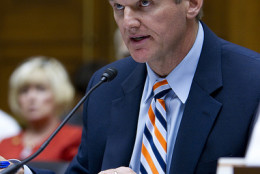Federal Retirement Thrift Investment Board
-
The Federal Retirement Thrift Investment Board, the agency that administers the Thrift Savings Plan, is also keeping a close eye on 2018 budget process. The board says the proposed changes to the federal retirement system included in the president's budget request could have significant impacts for retirees and how they participate in the TSP.
June 01, 2017 -
The Federal Retirement Thrift Investment Board is losing its executive director of 10 years. Greg Long announced his resignation during the board's monthly meeting. In the interim, the agency's chief investment officer, Ravindra Deo, will serve as the acting executive director while the board conducts a national search for a new leader.
April 24, 2017 -
Cybersecurity remains a tough challenge to tackle for Federal Retirement Thrift Investment Board, the agency that administers and oversees the Thrift Savings Plan. Under the Federal Information Security Modernization Act (FISMA), an independent auditor found the board lagging on risk management and access strategies.
February 27, 2017 -
The Federal Retirement Thrift Investment Board, the agency that facilitates the Thrift Savings Plan, is preparing for two major projects next year. The new blended retirement program for military members and the agency's long term IT modernization plan are the driving factors behind the agency's 17 percent budget increase in 2017.
September 19, 2016 -
In today's Top Federal Headlines, a new report shows that while some agencies are improving, the federal government still ranks among the worst for customer experience.
September 06, 2016 -
Two postal reform bills passed the House Oversight and Government Reform committee, although not without opposition or concerns.
July 13, 2016 -
The Thrift Savings Plan is warning enrollees not to make rash decisions as a result of a down market, following Britain's vote to leave the European Union.
June 24, 2016 -
Self service and longer hours for the call center are two goals of an ambitious project to update the way the Thrift Savings Plan interacts with federal employees. Kim Weaver, director of external affairs for the Federal Retirement Thrift Investment Board, joins Federal Drive with Tom Temin with a status report on Project ExPRESS.
May 27, 2016 -
The Federal Retirement Thrift Investment Board may need to ask for more resources to get through the rest of fiscal 2016, the agency's leadership warned. The board predicts the money it spends on cybersecurity upgrades and external audits will likely force the agency to exceed 2016 budget allocations before the year ends.
April 25, 2016 -
The Federal Retirement Thrift Investment Board, which administers the Thrift Savings Plan, is looking at best practices in the private sector to help strengthen the board's own cybersecurity and network penetration testing procedures.
March 29, 2016 -
Three proposals hiding in the fiscal 2017 budget plan House Republicans submitted last week could potentially impact federal employees' pay and retirement benefits in the future.
March 29, 2016 -
The Federal Retirement Thrift Investment Board predicts it will have 500,000-750,000 new participants to the TSP by 2019, one year after major changes to the military retirement and pension system go into effect. The 2016 National Defense Authorization Act requires new military members participate in the TSP starting in 2018.
December 14, 2015 -
Just weeks after new federal employees began placing their retirement savings into Lifecycle Funds by default, the board that governs the plans is considering changing how it allocates investments in the funds. Kim Weaver, director of external affairs at the Federal Retirement Thrift Investment Board, the panel that oversees the TSP, talked to In Depth with Francis Rose about the L funds, and some of the changes the board is looking at.
October 28, 2015 -
The Congressional Budget Office says the TSP G Fund investments will stop on Oct. 30 unless Congress can reach a deal, but feds won't see their savings dip.
October 19, 2015 -
The Thrift Savings Plan has something federal agencies don't have. The Federal Retirement Thrift Investment Board approved a $219 million budget for the coming year. In Depth with Francis Rose told Kim Weaver, director of External Affairs at the TSP, that TSP participants are probably jealous of her agency since it's budget is already in place.
September 15, 2015











